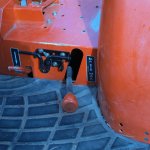Tried that yesterday. Did not make much of a difference.
Keep in mind, when the front tire make one full rotation, the rear tire is at the 2 o'clock position. Thats about a 35% front tire lead, I think...
Maybe I am missing something. I cant believe the tires are that mismatched with the ratio. The Rolling Circumference for front and rear tires are provided by manufacturer. 106 for rear, 68.9 for front. When I enter those in the Titan Lead/Lag calculator using the B8200 Mechanical Ratio of 1.691 it equates to a 9.92% lead. The B8200 Mechanical Ratio should be good because it uses the same exact tires as the B2150. It makes sense that the ratio is also the same.
rScottys, how do we find the "internal mechanical ratio (which I call the 4wd ratio) of the tractor gearing"?
I also found that adjusting the tire pressure did not make much of a difference in rolling circumference. But it might be because of the tires I used. Different tires could react differently.
It is easy to use the paint blob test and find out exactly how much - if any - difference it does make for your particular tires. I found a larger difference just with errors in my measurements than I could find with PSI. It is downright weird how the paint blob test shows me that I don't steer straight.
No, I doubt that 35% is accurate. Also I'm not sure I agree with that way of measuring.....
As for the B8200 mechanical ratio being good because of the tires being the same I would agree that is a good place to start. And in fact the ratio of 1.691 is a number that sounds familiar to me. It's been awhile since I did the tire swap (ag to turf) on the Yanmar YM336D tractor, but darned if that number doesn't sound familiar!!
So, if using that 1.691:1 number and the correct rolling circumference numbers gives you a 9.92% lead I would be inclined to believe it. And here is why:
We know that just how much lead to design for is going to always be a debate. However, I did measure and communicate with other owners who measured several other Japanese compact tractors over the years and have come to believe that the Japanese compact tractor manufacturers have a general general mechanical philosophy is to try to stay under 10%....but they don't mind being very close to 10%. That's quite a bit of lead, and could explain why you see some front drive shaft/U joint problems with several models of Japanese compacts.
If you suspect yours is close to 10%, then that's not unusual or surprising, but also a good reason to be choosey about the surface traction when using 4wd. Especially with a bucket load. Even more so when turning.
From what I've heard and the one that I measured , older US heavy loader/tractors and TLBs seemed to be designing closer to 5% lead or less. It obviously depends a lot on tire wear. I personally prefer 5% as a max on my own equipment.
We can kick it around and maybe we should. What do you think would be a good number for lead %? It's important that it be a positive lead for the fronts, but beyond that I think it's opinion as to just how much to design for. Has to do with windup stress and traction. Fuzzy numbers.
For curiosity, I set the 33 hp Yanmar (my wife's tractor) up with brand new tires and as near as I could get to zero percent lead but still slightly positive. Way less than 1%. Worked fine. It would smoothly shift into and out of 4wd at road speed just from road vibration. I ended up putting a latch on the 4wd lever. Now I do that on everything. (see attachment below)
MEASURING THE INTERNAL RATIO THE EASY WAY:
If you are careful, you can measure the internal ratio (engine off) by jacking up one side of the tractor, putting it in 4wd, and then using a very accurate pointer - like a piece of welding rod - to a chalk mark on the front and rear tires.
NOW PUT THE TRACTOR IN NEUTRAL, SO THAT THE POSITION OF THE CLUTCH DOESN'T MATTER. (edited thanks, Lou)
Slowly hand rotate the front tire, counting how many rotations of the front tire it takes until both tire marks line up again. That generally happens when the rear tire has made one complete revolution. Go very slow so as not to confuse things - you don't want to engage the differential spiders.
Do it a few times to confirm...you should get the exact same numbers again every time. If the numbers are way off and you counted right, repeat the test, but this time jack up the other side of the tractor. I found that sitting on a stool by the front tire was the best position to do my counting. Darn, I can't find my notes right now, but it can be a lot of rotations of the front wheel before the rear crawls around to the mark again. Anyway, when you are satisfied that you are getting good numbers that repeat, that rotation ratio IS YOUR INTERNAL GEAR RATIO.
I wonder if it will turn out to be very close to 1.691?
Enjoy, rScotty
